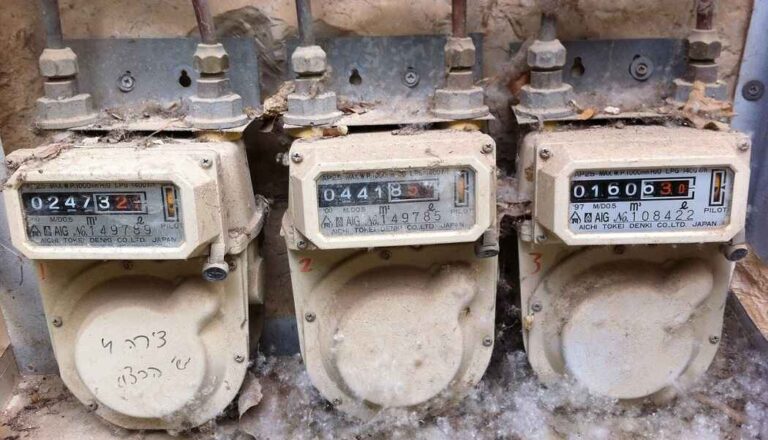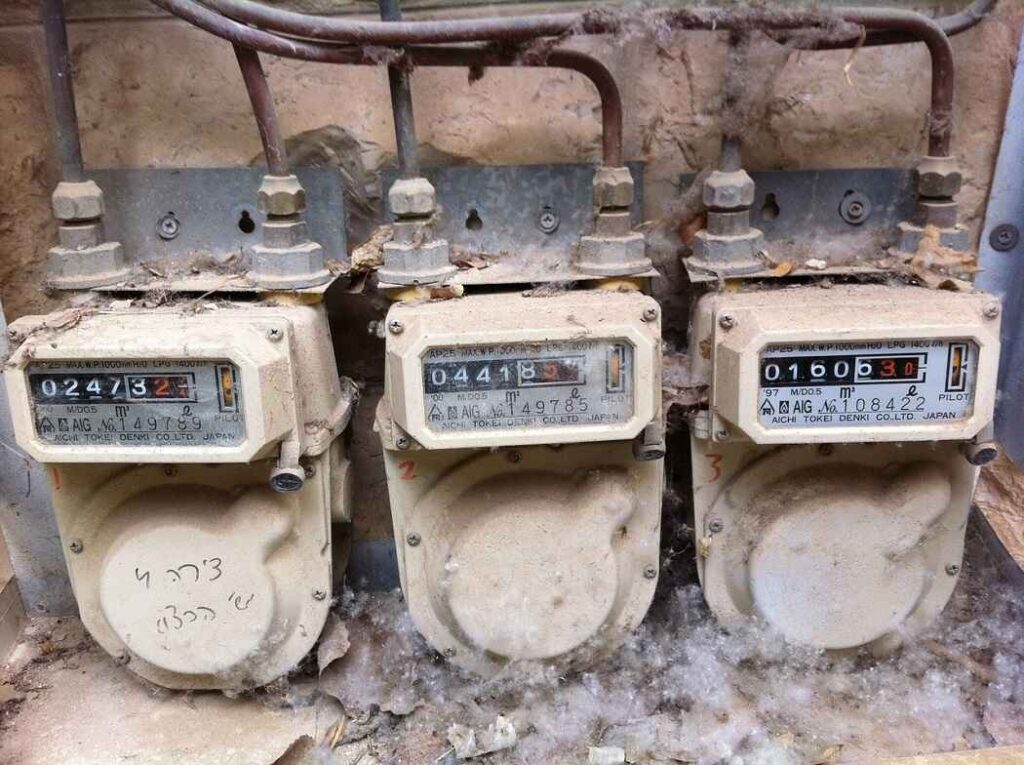
What Color Can I Paint My Gas Meter?
Gone are the days when gas meters were solely functional objects relegated to the corners of our homes. Today, homeowners are embracing a new perspective, viewing these inconspicuous devices as a canvas for creative expression. The question lingers in the minds of many:
What color can I paint my gas meter? Typically, gas meters should be painted in a light color, such as white or light gray, to reflect sunlight and prevent excessive heat absorption.

Read on to learn more.
Can I Paint My Rusting Gas Meter?
Yes, you can paint your gas meter, but it’s essential to proceed with caution and adhere to specific guidelines to ensure safety and functionality.
First and foremost, contact your gas provider to inquire about their policies on painting gas meters, as they may have specific rules or restrictions. Once you have the green light, choose a high-quality, weather-resistant paint suitable for metal surfaces, such as acrylic or enamel paint.
Ensure the selected paint is non-flammable and does not produce toxic fumes. Before painting, thoroughly clean the gas meter to remove any dust, dirt, or debris, and make sure it is completely dry before applying the paint. When painting the gas meter, be careful to avoid covering critical components like vents, dials, or safety labels. Use painter’s tape or other protective materials to shield these parts.
Maintain visibility of the meter’s identification numbers and readings after painting, as this information is crucial for gas company personnel during inspections. Periodically inspect the painted gas meter for any signs of peeling or damage, and perform touch-ups as needed to maintain its appearance and protect the metal surface.
Always prioritize safety and consult professionals if you have any doubts or concerns throughout the process. By following these steps and guidelines, you can successfully paint your gas meter without compromising its functionality and while complying with your gas provider’s regulations.
What Kind of Paint Should Be Used to Protect Gas Meter?
To protect a gas meter, it is essential to use the appropriate paint that can endure outdoor conditions and provide optimal protection. The most suitable paint for protecting gas meters is an outdoor-grade enamel paint. Enamel paints are well-known for their durability and resistance to weathering, making them ideal for use on outdoor surfaces.
When selecting paint, here are some key factors and considerations to keep in mind:
Non-Flammable and Non-Toxic: Safety is of utmost importance when dealing with gas meters. Ensure that the paint you use is non-flammable and non-toxic to prevent any potential hazards, especially considering the flammable nature of the gas.
Heat Resistance: Gas meters can be exposed to varying temperatures, so the paint should be heat resistant to prevent it from deteriorating or melting over time.
Corrosion Resistance: Protect the gas meter from corrosion caused by moisture, chemicals, or environmental factors. Rust or corrosion could compromise the integrity of the meter and lead to leaks or inaccurate readings.
UV Resistance: If the gas meter is installed outdoors or in an area exposed to sunlight, UV-resistant paint should be used to prevent fading and degradation caused by ultraviolet rays.
What Color Can I Paint My Gas Meter?
When it comes to painting your gas meter, it’s essential to choose a color that not only looks appealing but also complies with safety regulations and guidelines. Take a look at our few suggested colors-
Safety yellow or caution yellow: In many regions, gas meters are required to have a specific color or finish for identification and safety purposes. The most common color for gas meters is “safety yellow” or “caution yellow.” This vibrant yellow color helps make the meter easily recognizable and alerts people to the presence of a gas supply point.
Neutral Colors: Many gas utility companies recommend using neutral colors to paint gas meters. Neutral colors blend well with most surroundings and are less likely to attract attention, making the meter less conspicuous. Colors like beige, light gray, or muted green are often good options.
Camouflage: Camouflage-themed colors involve patterns that mimic natural elements like foliage, rocks, or bark. These patterns can be applied as wraps or coatings to the gas meter, making it blend in with its surroundings effectively.
If your gas meter is located in a prominent spot and you find its appearance bothersome, consider painting it to blend in with the surroundings. Using colors that match the exterior of your house or the surrounding landscape can help camouflage the gas meter.
Bright and Vibrant Colors: Using brighter colors for gas meters allows for artistic expression, potentially turning them into eye-catching elements rather than mere functional devices. It can make gas meters more noticeable, which could be helpful in emergency situations or for utility workers locating them easily. This approach could involve vibrant colors like red, blue, green, or even artistic designs or murals.
Avoid Dark Colors: Dark colors, such as black or dark blue, should be avoided, as they tend to absorb heat and may cause the gas meter to overheat, affecting its accuracy or functionality.
Reflective Paint: Some utility companies recommend using reflective paint for safety purposes. This type of paint enhances visibility during low-light conditions, making it easier for utility workers and emergency personnel to locate the meter if needed.
How to Paint Gas Meter Safely?
Painting your gas meter can be a simple and satisfying project, but it’s essential to approach it safely and responsibly. The gas meter is an important part of your home’s infrastructure, so it’s crucial to follow these steps to ensure you don’t cause any damage and maintain safety standards:
Choose the right paint: Select a high-quality, weather-resistant paint suitable for outdoor use. Look for paints labeled as “exterior” or “outdoor” paints that can withstand various weather conditions. Acrylic or enamel paints are often good choices as they adhere well to metal surfaces.
Gather Necessary Materials:
- Safety gear (including gloves and eye protection)
- Paint suitable for outdoor use and approved for metal surfaces.
- Paintbrushes or paint rollers.
- Painter’s tape or masking tape.
- Drop cloths or plastic sheets to protect surrounding areas.
- Cleaning supplies (water, mild soap) to clean the meter surface.
Prepare the Gas Meter Surface:
- Before starting, make sure to turn off the gas supply to the meter. Safety should always come first, and working on an active gas meter can be extremely dangerous.
- Clean the surface of the gas meter thoroughly to remove any dirt, dust, or grease that could interfere with the paint adhesion. Use a mild soap and water solution and allow it to dry completely.
Apply the Paint:
- Once the surface is clean and dry, use painter’s tape or masking tape to cover any areas you want to avoid painting, such as the gas meter’s gauge or any labels.
- Begin applying the paint using a brush or paint roller. Follow the manufacturer’s instructions for the paint application to achieve the best results.
- Apply the paint in thin, even coats to ensure proper coverage. Avoid drips or pooling of paint as it can affect the meter’s functionality.
Allow Sufficient Drying Time:
- After painting, allow the first coat to dry completely before applying additional coats. Follow the drying time specified on the paint can, as it may vary depending on the type of paint used.
- If necessary, apply a second coat to achieve the desired finish.
Inspect for Safety and Touch-ups:
- Once the paint has dried thoroughly, inspect the gas meter carefully to ensure that no critical parts or safety features are covered or obstructed by the paint.
- Check for any touch-ups needed to improve the paint’s appearance and fix any areas with uneven coverage.
Safety precautions:
- Never paint over vents, ports, or any operational components of the gas meter.
- Avoid painting the meter’s serial numbers, safety warnings, or any essential labels.
- If you’re uncomfortable working around gas meters or unsure about the process, consider hiring a professional painter.
Is It Safe to Paint a Gas Meter?
It is safe to paint a gas meter when you have obtained approval from the gas utility company, use paint suitable for outdoor metal surfaces, and ensure critical components and safety markings are not covered.
Professional application is recommended. Otherwise, amateur painting may lead to damage and safety hazards. Incorrectly painted meters can pose risks of gas leaks and accidents.
Is It Legal to Paint My Gas Meter?
Laws regarding painting gas meters vary by jurisdiction. It is essential to consult your local gas utility company or relevant authorities to determine whether painting your gas meter is permitted. In some areas, painting gas meters might be prohibited due to safety concerns or obstruction of identification.
Final Words
It’s crucial to remember that gas meters are important safety devices that need to be easily identifiable and accessible in case of emergencies. So, safety should never be compromised for aesthetics.
By following the appropriate guidelines, you can strike a balance between enhancing your property’s visual appeal and ensuring the reliable and safe operation of your gas meter.
